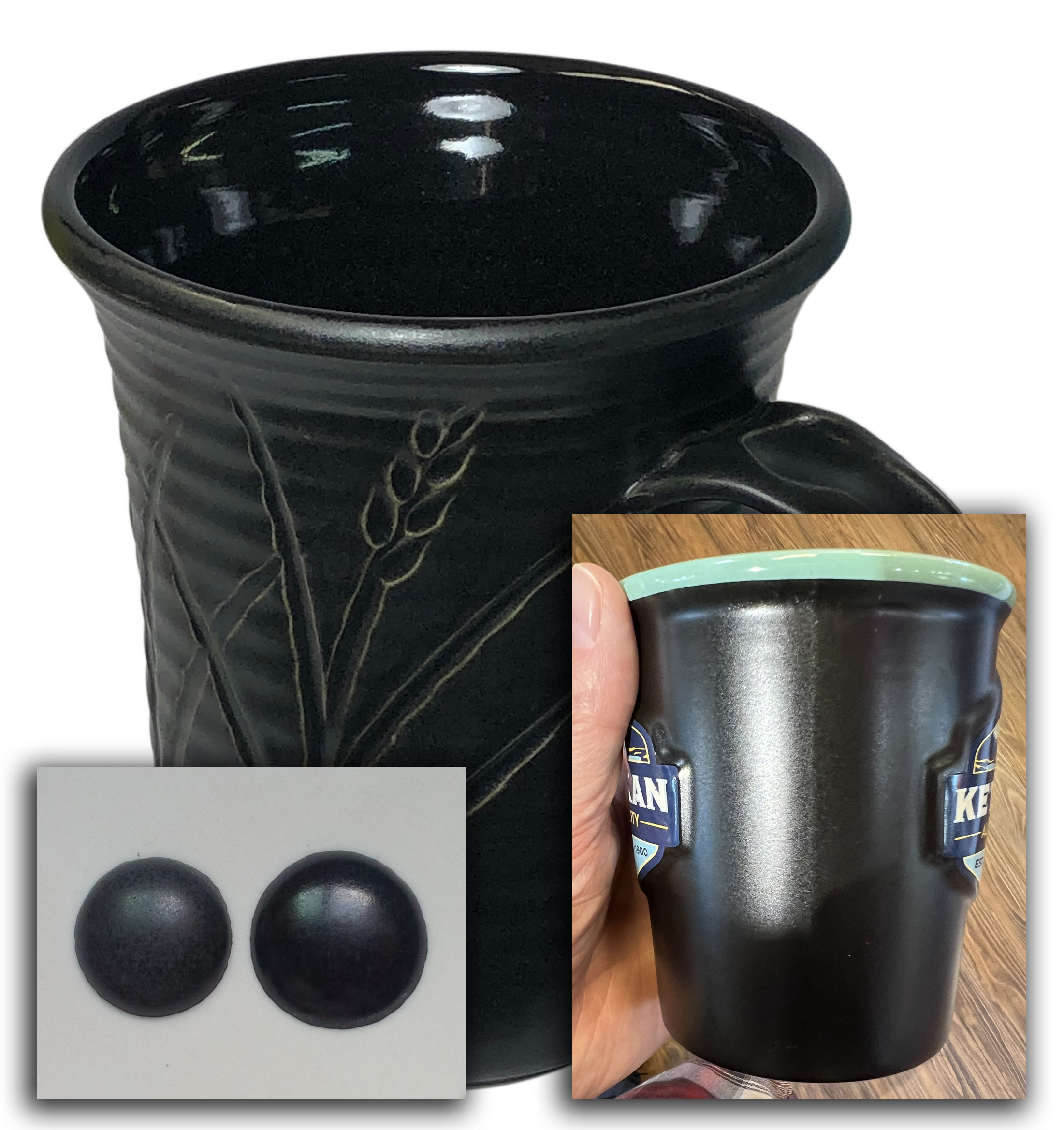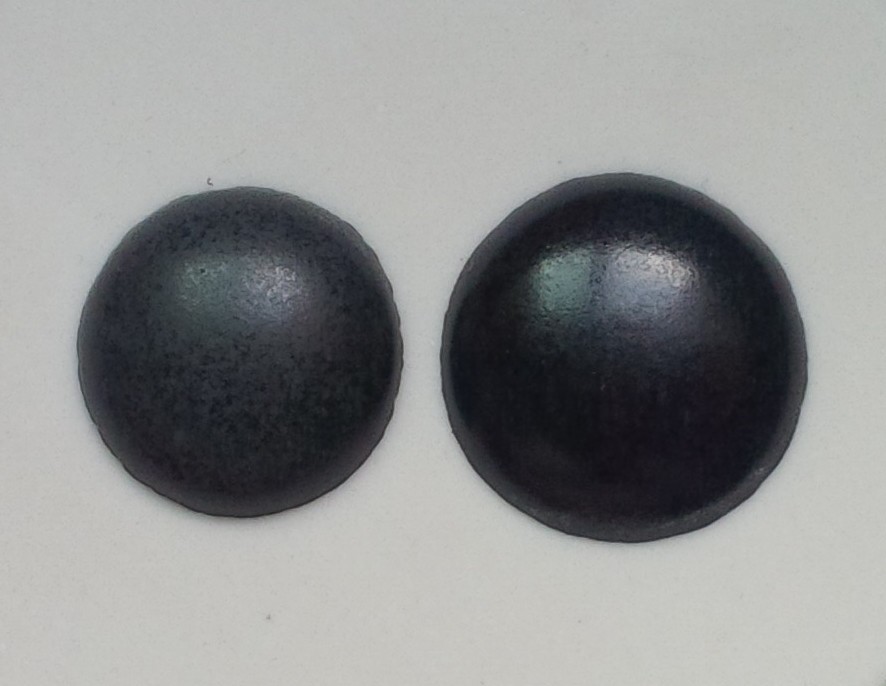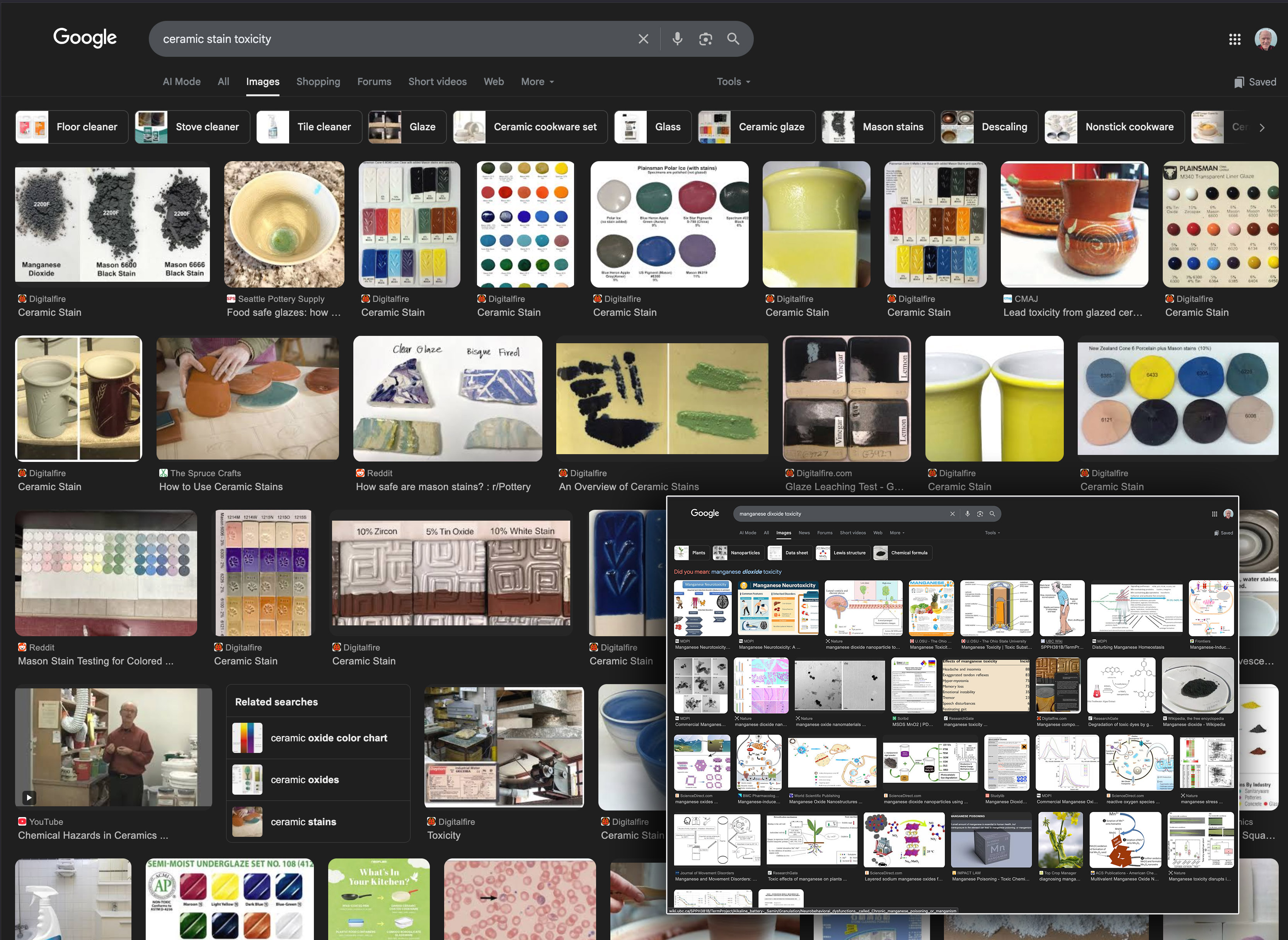| Monthly Tech-Tip | No tracking! No ads! |
Two cone 6 black glaze recipes I control and adjust
A gloss and a matte based on two reliable base recipes
The clay is Plainsman M370. Fired at cone 6 using the PLC6DS drop-and-hold firing schedule. The inside glossy glaze is G2926BL. The outside glaze base is G2934BL matte. Both recipes contain 6% Mason 6600 black stain. G2934 is tricky to keep consistent because the matte surface is a product of both the chemistry and the firing schedule. Thus, we faced lots of testing when it became necessary to substitute Ferro Frit 3124 for the supposed equivalent, Fusion Frit F-19. Early results showed a little better melting, so the 10-15% glossy we normally add to move the stony matte toward satin is not needed. However, we still made an 85:15 batch for our more frequent slow-cool C6DHSC firings (otherwise this G2934 mug would have fired too matte). So with the two recipes and two schedules, I can produce four surfaces, from gloss satin to stony matte. Digitalfire was the first online source of a matte black functional glaze with tunable matteness.
Related Pictures
Stains are better in black glazes
Use 5% stain instead of 15% metal oxides

This picture has its own page with more detail, click here to see it.
Consider the hazards and hassles before choosing a black matte or gloss recipe that has high individual or combined percentages of manganese dioxide, cobalt or nickel.
Gloss blacks: These are super popular right now as the base for layering of reactive glazes. DIY dipping versions thus make a lot of sense. They make even more sense when they don’t turn to jelly in the bucket because of the high percentage of red iron oxide in all blacks made using metal oxide colorants. And when the total percentage of pigment is as high, or higher than 15%. And when the pigments cause crystallization (especially when overloaded).
Matte blacks: The human eye can detect even slight differences in the degree of matteness (which is very difficult to keep consistent). Raw metal oxides affect the matteness, especially when overloaded with pigment. They are prone to cutlery marking if too matte. By using stains manufacturers, and even potters, have learned to tune recipes (lower left) and firing schedules to achieve consistency and functionality (even tourist souvenirs (lower right) feature them now). With stains, only one material is producing the color, its percentage (which can be as low as 4%) can be tuned.
Souvenir mugs that demonstrate incredible workmanship, glaze recipes, use of decals

This picture has its own page with more detail, click here to see it.
These porcelain mugs are sold at many tourist shops on the Alaskan cruize circuit. Made in China of course. But their quality is astounding. And they teach multiple lessons to potters - great skill in the use of decals (even inside), meeting different glazes at the rims, evenness of application, layering, the use of wax resist, etc. They likely have a glossy and matte base glaze and add stains (to get the black, blue, red, white, green). Notice they have an iron red (lower right) that is stable enough not to run and host an even more fluid melt second layer. They also have a stoney yet functional matte white (bottom left). And they are using encapsulated stains to get that bright red (even on food surfaces). You can make dipping glaze versions of all of these:
Black glossy: G3914A and G2926BL
Black matte: G2934BL
Iron Red: G3948A
White stoney matte: G2934Y2
Glossy colors: Add stains to G2926B
Matte colors: Add stains to G2934
Cutlery marking on matte black glaze

This picture has its own page with more detail, click here to see it.
This is G2934BL glaze fired using the C6DHSC slow-cool firing schedule, this has enabled too much crystallization. This mark cannot be rubbed off, matte black glazes show the marks more than others. If I had fired it using the PLC6DS free-fall schedule, it would have been glossier. Or, I could blend in a greater percentage of the glossy black. This being said, for this type of piece some cutlery marking can be tolerated.
Tuning the degree of gloss on a matte black glaze

This picture has its own page with more detail, click here to see it.
These 10-gram balls were fired and melted down onto a tile. The one on the left is the original G2934 Plainsman Cone 6 MgO matte with 6% Mason 6600 black stain. On the right, the adjustment has a 20% glossy G2926B glaze addition to make it a little less matte. Notice the increased flow (the ball has flattened more) with the addition of the glossy. In addition, while the percentage of stain in the one on the right is actually less (because of the dilution of the transparent), the color appears darker! Tuning the degree of matteness when making color additions is not just for appearance, for functional ware it is also about achieving a surface that does not cutlery mark and is not leaching heavy metals.
Cooling rate drastically affects the appearance of this glaze

This picture has its own page with more detail, click here to see it.
This is the G2934Y satin matte glaze recipe with Mason 6600 black stain (6%). The piece on the left was fired using the C6DHSC firing schedule (drop-and-hold at 2100F then 150F/hr to 1400F). The one on the right was fired using the PLC6DS schedule (drop-and-hold at 2100F then free-fall from there). The slow cooling rate gives the glaze on the left time to crystallize, creating a stony matte (and altering the colour accordingly). My kilns are generally lightly loaded, so free-fall firings drop rapidly, producing the effect on the right. This phenomenon is a characteristic of high MgO glazes (ones having significant dolomite, talc, Ferro frit 3249). To vary, by recipe, the degree of matteness, we also make this glaze using a blend of G2934 base (which fires even more matte on slow-cool) and G2926B glossy (starting with and 80:20 matte:glossy mix). Of course, this type of glaze would not be practical in an industrial shuttle kiln, pieces would fire differently depending upon their placement on the cars.
Heres evidence that using a black stain is safer than manganese dioxide

This picture has its own page with more detail, click here to see it.
A search for "ceramic stain toxicity" shows 19 digitalfire hits out of 32. Pretty well all of these pages refer to the increased toxicity of metal oxides over stains. No alarm. However, a search for "manganese dioxide toxicity" (lower right) is alarming (with disturbing words like neurotoxicity, movement disorders, Parkinson’s, distonia, liver disease, iron depletion, etc.). So then, why are so many potters still using recipes for black that contain high percentages of manganese dioxide? Although many black glazes use a combination or iron oxide and cobalt (e.g. 10%/2%), that does not work as well so manganese is still commonly employed (along with other metal oxides). There is a better way: Black stain in a proven base recipe (like GA6-B, G2934, G2926B), as little as 4% is possible. The decreased bioavailability of stains and and the much lower percentage needed make them a no-brainer for coloring glazes more safely.
Videos
Links
| Glossary |
Matte Glaze
Random material mixes that melt well overwhelmingly want to be glossy, creating a matte glaze that is also functional is not an easy task. |
Got a Question?
Buy me a coffee and we can talk

https://digitalfire.com, All Rights Reserved
Privacy Policy

